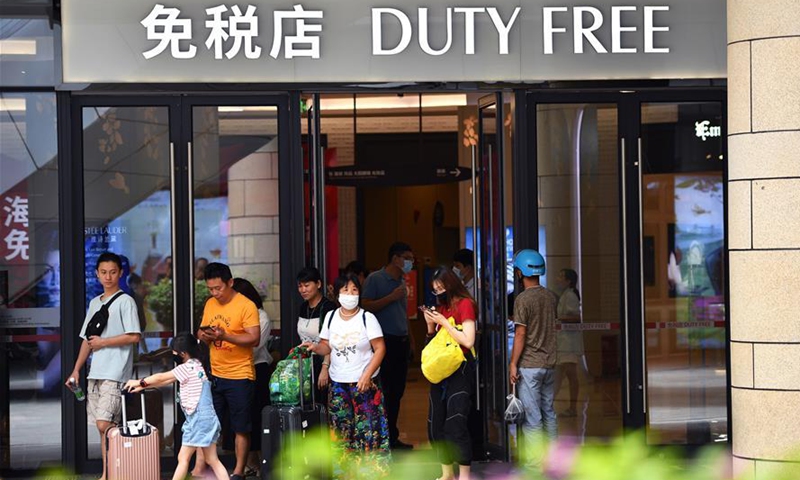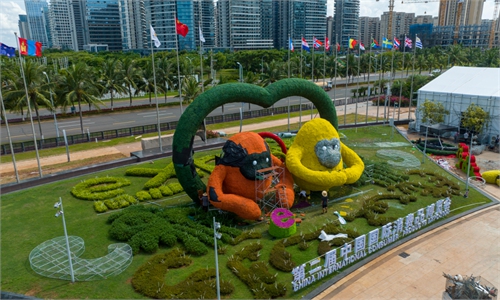Data shows Hainan on fast track to become consumption-powered free trade port: white paper

Photo:Xinhua
A national push to build a free trade port (FTP) with Chinese characteristics in the tropical resort island of Hainan has made conspicuous headway over the past year, with increased facilitation in trade, investment, cross-border capital flows, among other spheres, according to an official white paper on the FTP construction issued on Friday.
As part of efforts to materialize the strategic push, the island province has rebalanced its economy away from reliance on the real estate sector toward being consumption-powered, per the white paper released during the second China International Consumer Products Expo (CICPE) in Haikou, capital of South China's Hainan Province.
The white paper, the second of its kind, was compiled by the Hainan provincial FTP working committee.
A number of key policies have been implemented since a master plan for the Hainan FTP construction was unveiled by the State Council, the country's cabinet, in June 2020. Among the policies were imports of self-use production equipment eligible for zero tariffs that are subject to a negative list management, transport vehicles and yachts being exempt from tariffs that are under the purview of a positive list, and yet another positive list for management of raw and auxiliary materials entitled to zero tariffs.
As of May, imports falling under the categories of these zero tariff policies had already hit 9.89 billion yuan ($1.47 billion), according to the white paper that outlined the FTP progress between June 2021 and this May.
In a sign of streamlined regulatory procedures for international trade, the customs clearance of imports through the Hainan port stood at 35.15 hours in May, 21.28 hours less than the national average. Customs clearance of exported goods was also shortened by 0.74 hours to an average of 0.57 hours.
Last year, the island's merchandise imports and exports totaled 147.68 billion yuan, a surge of 57.7 percent from the year before, 36.3 percentage points higher than the national average.
In the first five months of the year, the island's merchandise trade gained 61.4 percent year-on-year to 74.57 billion yuan.
The island has also made strides in enhancing intellectual property rights protection and fair competition. In 2021, the province granted 13,632 patents, an increase of 58.9 percent from the previous year. Rules for fair competition in the Hainan FTP were approved in late September 2021 and came into force on January 1, according to which the first fair competition committee was created in the domestic market.
Such incentives apparently augur well for businesses looking to growth opportunities in the FTP's wake.
By May, the province's newly established market entities amounted to 1.09 million, the white paper disclosed, and its actual use of foreign investment skyrocketed 80.6 percent year-on-year to $1.44 billion in the first five months.
The Friday paper also sketched out the FTP's headway in financial opening, globalization of varied exchange hubs in the province, cross-border capital flows, transport connectivity, flows of people, and secured data flows.
Hainan occupies a unique geographic position, connecting the South China Sea trade passageway and serving as a strategic pivot in the Belt and Road Initiative (BRI). Building the Hainan FTP helps in fostering regional cooperation under the BRI framework as well as in pushing China's trade and investment liberalization and opening the domestic market wider to the outside world, Jennifer Ye, PwC Chinese Mainland Consumer Markets Leader, told the Global Times on the sidelines of the CICPE.
The island province is set to make access to the services sector easier for foreign investment as it aims to be primarily driven by tourism, modern services and high-tech industries, Ye said, expecting these sectors to embrace new development opportunities and consequently funneling advanced technologies, experiences and high-quality talent into Hainan.
Having bid a farewell to a long-term dependence on the property sector, the island province's economy has now based its high-quality development upon four major industries - tourism, modern services, high-tech, and high-efficient tropical agriculture, the white paper said.
Last year, tourism revenues rose by 31 percent from the pre-COVID-19 2019, the paper revealed, noting that consumption has become a main engine for local economic growth.
The island's duty-free stores recorded 60.17 billion yuan in total sales, including tax paid, in 2021, up 84 percent year-on-year, according to a separate white paper on Hainan travel retail market jointly released by KPMG and The Moodie Davitt Report at the consumer expo on Tuesday.
"Hainan stands out from world travel retail destinations because of a series of innovative institutional measures improving the business environment," the paper found.
The Moodie Davitt Report, a London-based business intelligence service, reckoned that "Hainan is on course to become the world's biggest duty free market over the next five years."



